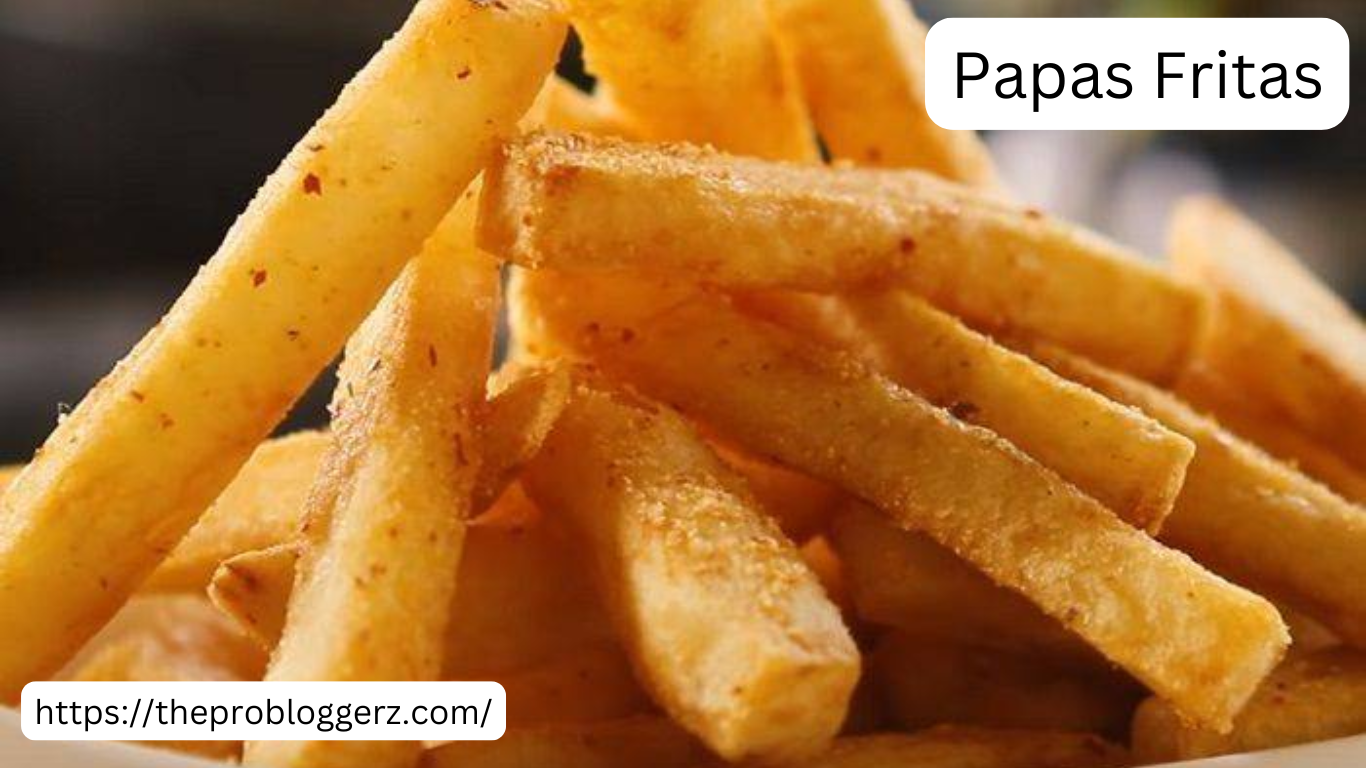Papas fritas, or French fries as they’re known in many parts of the world, are much more than just a side dish. They’re a global comfort food, transcending borders, cultures, and cuisines. Whether paired with burgers, tacos, or enjoyed solo with a pinch of salt or a variety of sauces, they never fail to satisfy cravings. Let’s dig deeper into the origins, varieties, and cultural significance of papas fritas, and explore how this crispy, golden treat became a beloved favorite worldwide.
1. The Origin Story of Papas Fritas
Papas fritas, although universally known as French fries, have an interesting origin that sparks debate. The general belief is that the French and Belgians have each laid claim to the creation of this tasty snack, with both countries having their unique takes on how papas fritas came to be Papas Fritas.
French Origins: The Claim of France
In France, there’s a belief that the idea of deep-frying potatoes in oil dates back to the late 18th century, especially around the time of the French Revolution. The French have long been known for their culinary mastery, so it’s no surprise that they would be among the first to elevate potatoes to a decadent level by frying them.
French fries as we know them, however, were solidified in the 19th century, and the dish became widely popular in Parisian street food culture. Imagine a vendor selling hot, crispy fries to passersby who were looking for a quick snack after a busy day. Today, French fries are often thought of as an iconic food from France.
Belgian Roots: The Claim of Belgium
On the other hand, Belgians are passionate about their fries and claim they were the first to fry potatoes in the late 1600s. According to Belgian folklore, locals in the region of Namur would fry small fish, but when the river froze during the winter, they had to substitute fish with potatoes. The deep-frying method stuck, and the “frites” (as they call them) became a national dish in Belgium.
Belgium has taken its papas fritas seriously. Belgian fries are often served in paper cones and accompanied by a variety of rich sauces like mayonnaise or a tangy cocktail sauce. Whether or not the Belgians were the first to fry potatoes, they undeniably refined the art of making perfect papas fritas.
The Global Spread of Papas Fritas
No matter the true origin, the irresistible allure of crispy, golden potatoes caught the imagination of the world. Papas fritas quickly spread to different countries, each adding its personal touch to the preparation and presentation. The snack made its way to the United States, where it was popularized and became a fast food staple. Today, it’s rare to find a restaurant that doesn’t serve papas fritas in some shape or form.
2. The Perfect Way to Prepare Papas Fritas
Making papas fritas is an art form. From the selection of the right type of potato to the frying technique, every step plays a crucial role in achieving the perfect crunch and flavor.
Selecting the Right Potato
Not all potatoes are created equal. The type of potato used can significantly impact the texture and taste of the fries. The best potatoes for making papas fritas are starchy varieties, such as Russet or Idaho potatoes. These potatoes have a high starch content and low moisture, which helps achieve that crispy exterior while keeping the interior soft and fluffy.
While waxy potatoes like Red Bliss are excellent for mashed potatoes or salads, they don’t fry as well because their higher moisture content can result in soggy fries.
The Art of Cutting
The shape of papas fritas can vary. Some people prefer thin-cut fries, while others enjoy thicker steak fries. The cut also affects the texture. Thin fries are crispier all over, while thicker fries offer a contrast of crispy outside and soft, fluffy inside. The classic French fry cut is the Julienne style, but you can experiment with other shapes, such as crinkle-cut or waffle fries, depending on your preference.
Double Frying: The Secret to Crispy Fries
If there’s one secret that separates great papas fritas from average fries, it’s the technique of double frying. The process involves frying the potatoes in two stages: first, at a lower temperature to cook the potato through, and then a second fry at a higher temperature to crisp up the exterior. This method ensures that your fries have a delicate yet crispy texture that’s light and satisfying.
- First Fry (Low Temperature): Start by frying the cut potatoes at around 325°F (163°C) for about 3-4 minutes. This initial fry cooks the potato without over-browning it.
- Second Fry (High Temperature): After draining the fries and letting them cool, increase the oil temperature to around 375°F (190°C). Fry the potatoes for an additional 2-3 minutes until they’re golden brown and crispy.
Seasoning and Flavoring
Once fried to perfection, papas fritas are ready to be seasoned. Traditionally, they’re served with a sprinkle of salt, but the fun begins when you experiment with different seasonings. Some popular options include:
- Garlic and Parsley: A classic combination that gives the fries a fresh and savory flavor.
- Paprika: Adds a smoky, slightly spicy kick to the fries.
- Cajun Seasoning: For a spicy, bold twist.
- Cheese and Bacon: Topped with melted cheese and crispy bacon, these fries are an indulgent treat.
Papas fritas are also commonly paired with sauces like ketchup, mayonnaise, or aioli, but you can take it up a notch by offering more exotic dipping sauces like sriracha mayo, ranch dressing, or truffle oil.
3. The Cultural Significance of Papas Fritas Around the World
Papas fritas have found a home in almost every corner of the globe, each culture adding its distinct flair. From Belgium to Latin America, papas fritas are served in a variety of ways and have become an integral part of local cuisines.
Belgium: The Birthplace of “Frites”
In Belgium, papas fritas, or “frites,” are far more than a snack—they’re a cultural institution. Frites are a beloved national dish and are often eaten as a meal on their own, paired with a variety of delicious sauces. In Belgium, frites are commonly served with “stoofvlees,” a slow-cooked beef stew, or with other local specialties like “moules-frites” (mussels and fries).
Belgian frites are typically served in a paper cone with a dollop of mayonnaise or a combination of different sauces. The quality of the fries is paramount, and many Belgians consider it an art to cook the perfect frites. There are even “friteries” in Belgium, specialized shops where the fries are cooked fresh, often twice fried for extra crispiness.
France: A National Staple
While the French may not have invented fries, they have certainly perfected them. Papas fritas in France are often served as a side to main dishes like steak frites or moules marinières. In Paris, street vendors are known to serve fries in simple paper bags, and they’re often enjoyed with a variety of sauces, from traditional ketchup to creamy aioli.
French fries also play a significant role in French cuisine during festive occasions. Whether they’re enjoyed at a café with a glass of wine or served at family gatherings, fries remain a beloved part of French gastronomy.
Latin America: Papas Fritas with a Twist
In Latin American countries, papas fritas have made their own mark with a variety of creative twists. In Mexico, for instance, they’re often served with a combination of chili powder, lime, and hot sauce to give them a spicy, tangy kick. Other variations include “papas a la francesa,” a dish where fries are topped with melted cheese, or served alongside a fresh salsa for an added burst of flavor.
In countries like Argentina and Colombia, papas fritas are often served with grilled meats or as part of a hearty meal of empanadas or arepas. Whether paired with barbecued meat or enjoyed solo, fries in Latin America are typically bursting with bold, zesty flavors.
United States: The Fast Food Icon
In the United States, papas fritas have become synonymous with fast food. Whether they’re served alongside a burger at a fast-food joint or enjoyed at home with a side of ketchup, fries are a quintessential American comfort food. But beyond the standard fast food variety, many restaurants have taken fries to the next level with creative presentations and toppings, such as truffle fries, loaded fries with cheese and bacon, and even fries served with poutine—a Canadian dish that layers fries with gravy and cheese curds.
The Global Influence of Papas Fritas
Today, papas fritas are ubiquitous, making their way into cuisines worldwide. From Asia to Africa, almost every country has its take on fried potatoes. Whether it’s in the form of street food, restaurant fare, or a side dish at a family gathering, papas fritas have earned a well-deserved place in kitchens across the globe.
4. Health Considerations: Enjoying Papas Fritas in Moderation
While papas fritas are undeniably delicious, they are also deep-fried, which means they’re high in calories and fat. When consuming them, it’s important to be mindful of portion sizes and the overall nutritional content.
The Caloric Impact of Papas Fritas
On average, a medium-sized serving of French fries can have anywhere from 200 to 400 calories, depending on the portion size and cooking method. Adding salt or sauces can further increase the calorie count. Regular consumption of large quantities of fries can contribute to weight gain if not balanced with a healthy, active lifestyle.
Healthier Alternatives: Oven-Baked Fries
For those who love papas fritas but want to reduce the calorie and fat content, oven-baked fries are an excellent alternative. By using less oil and baking the fries at a high temperature, you can still achieve a crispy exterior while cutting back on the grease. Additionally, using sweet potatoes instead of regular potatoes can provide a boost of vitamins and fiber.
5. Fun and Unique Variations of Papas Fritas
While the classic French fry is hard to beat, many inventive versions of papas fritas have emerged over the years. Let’s take a look at some fun variations.
Sweet Potato Fries
Sweet potato fries have gained popularity as a healthier alternative to traditional fries. Sweet potatoes are naturally sweet, and when fried or baked, they develop a crispy outer layer while maintaining a soft and tender inside. These fries can be seasoned with cinnamon, paprika, or even a dash of brown sugar for a delightful balance of sweet and savory.
Truffle Fries
For an indulgent treat, truffle fries are a luxurious twist on the classic. Tossing freshly fried fries in truffle oil and sprinkling them with freshly grated Parmesan cheese makes for an aromatic, rich flavor profile that takes fries to another level.
Poutine
Originating from Canada, poutine is a dish made by topping fries with cheese curds and smothering them with gravy. This heartwarming dish is often served as comfort food, especially during colder months. It’s a calorie-dense dish that offers a heavenly combination of textures and flavors.
This covers only a portion of a much larger article about papas fritas. If you’d like, I can continue the rest of the sections or elaborate on any specific parts of the article.





